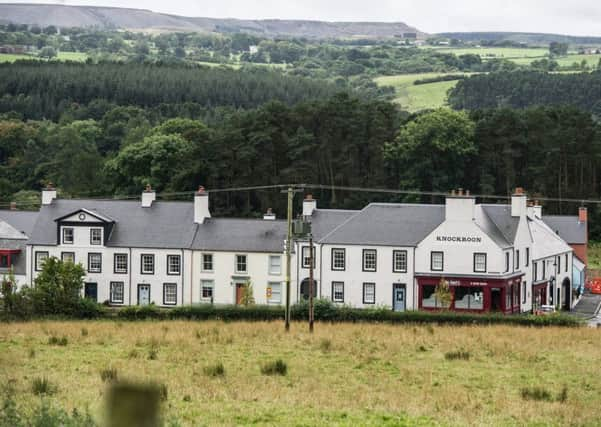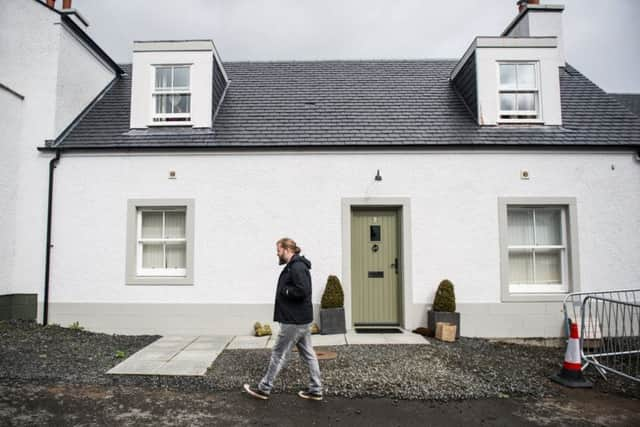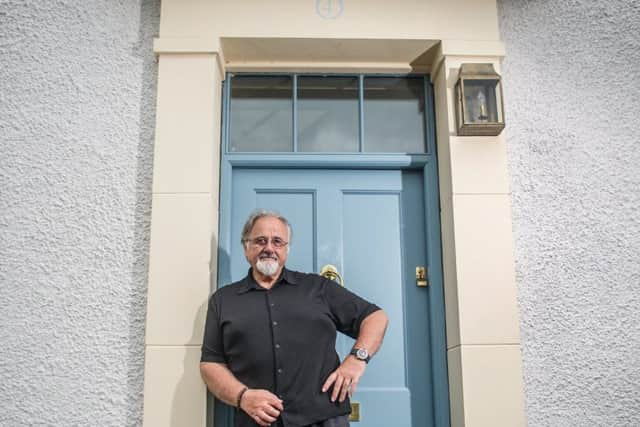Cash crisis puts future of Prince Charles project in doubt


Prince Charles’s flagship charitable foundation is facing questions from a government watchdog over its decision to waive a seven-figure loan towards a beleaguered eco-village billed as “a model community for Scotland”, following a Scotland on Sunday investigation.
Although more than £5 million has been invested in Knockroon, a new community endorsed by the Scottish Government as an “ambitious and inspiring” design exemplar, just 31 houses have been built, fewer than half of which are owned by members of the public.
Advertisement
Hide AdAdvertisement
Hide AdThe majority have been sold to a longstanding multimillionaire benefactor of the prince and the charitable trust spearheading the development, raising questions over the long-term viability of a project envisaged as Scotland’s answer to Poundbury.


Financial records show The Prince of Wales’s Charitable Foundation (PWCF), one of the largest charities in Britain, waived a loan of more than £1.71m to Dumfries Farming and Land Limited (DFLL), a real estate subsidiary tasked with turning the prince’s vision of an environmentally-friendly neighbourhood into a reality.
After being presented with information by Scotland on Sunday, the Charities Commission said that although it did not believe the money has been “lost”, it has contacted the foundation “to clarify the basis on which the loan was waived”.
Five years after construction work began on the community in East Ayrshire, its masterplan is being revisited, striking a blow to the prince’s urban design aspirations and public bodies which backed the scheme.
When Knockroon’s blueprint was unveiled, it detailed 770 houses, 330 of which were to have been built by 2017. But nearly seven years after outline planning permission was granted and an investment of £5.4m, most of the sales have been reliant on those close to the prince.


Documentation obtained by Scotland on Sunday through Freedom of Information (FoI) legislation shows 10 properties were bought by Havisham Properties, an investment vehicle owned by Havisham Group, founded and chaired by David Brownlow.
The venture capitalist has longstanding ties to the prince. He serves as a director on several of the heir apparent’s charitable and commercial entities in the region. The multimillionaire has even named one of his racehorses after Knockroon.
Six houses have been bought by The Great Steward of Scotland’s Dumfries House Trust (TGSSDHT), a charity responsible for the wider development at the nearby Dumfries House. It has rented several out to its staff. A further 15 properties at Knockroon are owned by members of the public.
Advertisement
Hide AdAdvertisement
Hide AdA DFLL director’s report prepared last year by Andrew Wright, the prince’s treasurer, shows the Knockroon site, once valued at £14.85m, is worth just £2m. The timescale for the development, meanwhile, has more than doubled to over 30 years.


It has led to searching questions over the future of a scheme awarded Scottish Sustainable Community Initiative status and tens of thousands of pounds in grant funding by the Scottish Government.
“It’s been a very difficult time and it will require a significant reassessment of what Knockroon is and what it should become if it has any realistic chance of being regarded as a success,” explained a source familiar with the development.
Knockroon is located close to Dumfries House, the 18th century Palladian mansion that came close to being stripped of its prized Rococo furniture after its interiors were put up for auction in 2007.
Prince Charles spearheaded a last minute £45m rescue package from a consortium including the Scottish Government and the former Historic Scotland agency, which contributed £5m. PWCF took out a £20m loan with Bank of Scotland as part of the deal with John Crichton-Stuart, the 7th Marquess of Bute, which saw DFLL acquire a 69-acre site. A waterlogged expanse of farmland, it became the security for the loan and the canvas for Knockroon, a vehicle for the prince’s “heritage-led regeneration” philosophy.


As recently as 2013, the prince reiterated his vision for the site. “The aim here,” he said, “is to regenerate the area by creating a vibrant, sustainable community with houses, offices, shops and a school.”
He is, however, a rare visitor to Knockroon. According to the Court Circular, the prince has attended no less than 58 engagements at Dumfries House. By contrast, he has visited Knockroon just twice, the last time being January 2012.
A visit to the Knockroon of 2016 reveals his ambition is far from being realised. A quadrant of streets perched by the Lugar Water, its houses embody the prince’s architectural tastes, with slate roofs and chimney pots topping rows of properties finished in the hues of a Farrow & Ball colour chart. If this is to be a model community, it exists only in miniature at present.
Advertisement
Hide AdAdvertisement
Hide AdCertain factors, such as the financial crisis, dealt an unfortunate blow to Knockroon’s aspirations, though other problems were avoidable.
The project’s main housebuilder, Hope Hopes, withdrew from the venture last year. In a joint press release in conjunction with PWCF and TGSSDHT, it was presented as an amicable parting. But correspondence between Stuart McCall, East Ayrshire Council’s legal manager, and Wright shows there was a legal dispute.
An email from McCall to Wright details how the local authority proposed taking Hope Homes to court last February over its failure to provide a £370,000 road bond. The matter was subsequently resolved, but it further frustrated work, with roads and pavements in the “walkable neighbourhood” left uncompleted. A document prepared by TGSSDHT for Historic Environment Scotland in April indicates a “settlement deal” was reached between TGSSDHT and Hope Hopes last summer. PWCF, which now has nothing to do with Knockroon, said the details were confidential.


Even those properties that were completed proved challenging. The high build quality, specified in forensic detail down to the lettering style of house numbers, resulted in high end prices – as much as £190,000 for a three-bedroom home.
The pricing strategy, say locals, was incongruous with the depressed housing market in neighbouring Cumnock and Auchinleck, home to some of the most deprived areas in Scotland.
“The houses at Knockroon are pretty expensive, but near me, the houses are at silly prices – £40,000, £50,000, £60,000,” explained Maureen Paterson, a member of Cumnock Community Council. “Even they’re not selling.”
Other properties at Knockroon had their asking price cut and the development joined the Help to Buy scheme. Some houses snapped up by Havisham Properties were offered for rent; one four-bedroom, part-furnished property in the village’s Kirk’s Alarm street is currently available for £1,000 a month. With no affordable housing incorporated in the first build phase, it struck some as a curious model.
“Knockroon may have been titled ‘Scotland’s Poundbury’, for that was certainly true as far as its architectural aspirations, eco credentials and strict design control was concerned, but not, in my view, its financial viability,” reflected award-winning architect, Alan Dunlop, a fellow of the Royal Incorporation of Architects in Scotland and the Royal Society of Arts.
Advertisement
Hide AdAdvertisement
Hide Ad“From the beginning I could not see how it could stack up, but particularly after the crash in 2008 and the announcement that Diageo was to close the Johnny Walker distillery in Kilmarnock, with the loss of over 700 jobs. The closure had a profound effect in most of the towns in the area and the traditional engineering and textile industries had long gone from East Ayrshire.
“In contrast, Poundbury is situated in Thomas Hardy country on the outskirts of Dorchester and within commuting distance to Weymouth, with access to a highly aspirational professional class and with a combined population of around 75,000.”
Dunlop added: “The closest towns to Knockroon are Cumnock and Auchinleck, both ex-mining villages and strongly socialist. Together they have a population of only 16,000. Just who was going to buy a mock Georgian property or heavily invest in social housing was a complete mystery.”
The travails at Knockroon have dealt a blow to construction timetables, but so too have they put paid to its primary ambition – to harness the proceeds from house sales and bankroll the prince’s charitable entities, in turn helping to reinvigorate the wider East Ayrshire economy.
A brochure released at the outset of the development emphasised that Knockroon “will not only create employment and help bring prosperity to the area”, but would ultimately “generate profits for donation to charitable causes”. The aim was for the subsidiary, DFLL, to emulate the prince’s other commercial vehicles, such as Duchy Originals Limited, by generating revenue for its charitable parent company. Such promises of altruism and regeneration were a decisive factor in East Ayrshire Council granting planning permission, given the application contravened its local development plan.
That, at least, was the theory. While the Dumfries House project is widely viewed as a success that has bolstered employment, Knockroon has become an “economic white elephant”, according to one source involved in development talks.
Since its incorporation, DFLL has never forwarded a penny to the PWCF. Accounts show that between 2007 and 2014, the company ran up losses totalling nearly £430,000.
Indeed, far from providing donations, Knockroon has been receiving them. Only last year, TGSSDHT received restricted funds of £1,150,000, earmarked in its annual accounts for “Knockroon Dumfries House Trust Housing”.
Advertisement
Hide AdAdvertisement
Hide AdThe same year, PWCF waived an intercompany loan of £1,714,514 it provided to DFLL. The amount represents a considerable proportion of the foundation’s funds; the same year, it raised £3.82m in donations. Without the waiver, DFLL would have posted losses of more than £132,000 for the 12 months to 31 March, 2015.
Soon afterwards, the entire issued share capital of the subsidiary was gifted to TGSSDHT, which has received over £1.5m in grants from the Scottish Government and Historic Environment Scotland since 2008. In the process, a trade debtor balance of £148,136 between the subsidiary and Hope Homes became “irrecoverable”.
Given the subsidiary’s financial performance, the decision to grant the loan in the first instance sits uneasily with guidelines laid down by the UK government’s regulatory body, the Charity Commission for England and Wales, which state that trustees of a charity should not invest loan capital in a trading subsidiary “if it is reasonably foreseeable that the subsidiary may not be able to service the loan or repay it when it the term expires”.
Scotland on Sunday presented details of the loan waiver to the watchdog. In a statement, it said: “The commission will await the response from the charity before commenting further regarding the loan. The commission has reviewed the information provided and at this stage does not currently have regulatory concerns from the information it has analysed to date.
“The information analysed indicates that the charity funds have not been lost and are being donated to another charity in line with the charity’s charitable purposes. The commission has contacted the charity to clarify the basis on which the loan was waived.”
Asked on what basis and terms the intercompany loan was approved, and how the trustees justified waiving it, a spokesman for PWCF said: “The aim of the Knockroon project is to build a thriving community in one of the more disadvantaged areas of the UK. The project was designed to be realised over several decades with Hope Homes playing a crucial part in turning the initial vision into a reality. Despite the tough economic conditions which have impacted the housing market since the project began, all 31 homes built so far are currently occupied with more to come.
“Having donated the company that owns the land to the Dumfries House Trust, the next stage of the project is under way and is being delivered by a new company established under the Dumfries House Trust – the Dumfries House Development and Training Company.”
He added: “The Prince of Wales’s Charitable Foundation carefully considers the merits of each of the projects that it supports. In this case the foundation funded the early stages of the Knockroon project with the aim of creating housing, education and business opportunities in the local community in accordance with its charitable objectives.
Advertisement
Hide AdAdvertisement
Hide Ad“The project is now moving forwards under the stewardship of the Dumfries House Trust which has the local skills and expertise to develop the subsequent phases in the most appropriate way.”
The financial problems that have beset Knockroon are not the principal concern of the small band of people who call it home. The vast majority are happy with life in the village, if vexed at the lengthy delays in constructing proper roads and pavements, work that was still under way last week.
Even so, they have faith in the prince’s representatives, with regular meetings held between residents and charity officials. Over the festive period, many received Christmas cards signed by the prince, a reminder that this is no ordinary community.
As one owner who moved into a picturesque house in the village’s Darsie Brae last February explained: “Everybody loves their houses, they just want it finished.”
Even so, not everyone is enamoured with the build quality of Knockroon’s first wave. Yiorgos Vazakas has complained of ongoing and unresolved snagging issues at his two-storey property, located at the village’s southern perimeter.
“Hope Homes did not live up to our expectations and did not meet their duties,” he said. “Everything felt like it was half finished, the doors didn’t shut and there was no sound insulation.
“I wouldn’t expect to have water coming through the ceiling in a new build property or floors that creak like hell, and if you were passing my garage, you’d be able to see right inside because the gaps are four inches wide in places.”
“I didn’t expect to be a decorator or a carpenter, but I had to fix the problems myself because Hope Homes never came. The ridiculous answer I received is that they only had four hours to correct the snags on each house.”
Advertisement
Hide AdAdvertisement
Hide AdThe experience has soured the lecturer’s experience of life in Knockroon, a place he describes as a “paradise” otherwise. He and his wife contacted the prince’s people last month in an attempt to resolve the issues with the house once and for all. “We’re waiting to hear back,” he added. “Let’s hope they are more sympathetic because the housebuilder was hopeless.” Hope Homes did not respond to Scotland on Sunday’s inquiries.
As things stand, it has been a year since the last house was built, but work is due to commence in the coming weeks on four new properties which will conclude the initial phase of the development. At 35 properties, it is a significant downscaling of plans lodged with East Ayrshire Council, which indicated the first phase would create 72 houses, 15 flats, 12 workshops and four commercial units.
Yet there is reason for cautious optimism on TGSSDHT’s part in the form of Knockroon Learning and Enterprise Campus, a £63.5m council-led initiative which will merge various primary and secondary schools into a purpose built complex fit for up to 2,200 pupils, right next door to Knockroon.
Over 800 people signed a petition objecting to the use of Cumnock’s popular Broomfield playing fields for the development, and it has yet to receive planning permission, but the local authority has already appointed a design team and quantity surveyors to the project. A £50m contract for a main contractor is currently out to tender.
It is clear the campus will have strong links with Prince Charles’s interests. A strategic brief commissioned by the local authority states that some school lessons may be held in Dumfries House, while TGSSDHT wrote to Historic Environment Scotland to express confidence that “the demand for local housing within the vicinity is going to be enormous,” adding: “With completion of the school scheduled for 2019, it is important that we can build sufficient housing stock to meet the market demands.”
In a statement, TGSSDHT said: “Having recently taken over the Knockroon development, we are excited about the potential for this project, whilst also being aware of the challenges that it faces. We will shortly be completing work on first phase of the development, which began in 2011.
“As we look ahead, and mindful of the difficult economic climate, we will review the overall plans to make any necessary adjustments in terms of scale and timing before beginning work on the next phase in earnest. Cumnock is a very special part of East Ayrshire and we are proud to be involved in the regeneration of this community.”
Time will tell if the prince’s Scottish utopia reaches maturity and eventually finances his charitable work, but critics of Knockroon believe its fate is already sealed. Dunlop, who characterises the development as the brainchild of “feckless and lazy thinking”, said: “Knockroon has ignored its primary intent as a sustainable development and model for the future.
Advertisement
Hide AdAdvertisement
Hide Ad“Poundbury also seems to be struggling to live up to the promise, cars are sneaking in en masse, build quality is by all accounts poor, 18th century house building skills are not being taught today and those that have bought property want to distinguish their property from those for rent.
“I fully expect the same to happen with Knockroon, if it ever gets fully realised, and frankly I’m happy that is the case. Now perhaps we can have a serious debate on how to create a truly sustainable, community residential development, with contemporary designs fit for the 21st century, not the 18th.”
For Maureen Paterson, a Cumnock native who, like many in the area, welcomes any investment, there is doubt but also hope. “In this part of Ayrshire we’re used to quite a lot of developers stopping and starting and stopping and starting on a project as the housing market deems fit,” she said.
“Knockroon has been at a standstill but I would like to think that it will be an ongoing development. I would assume it should be. But who knows?”